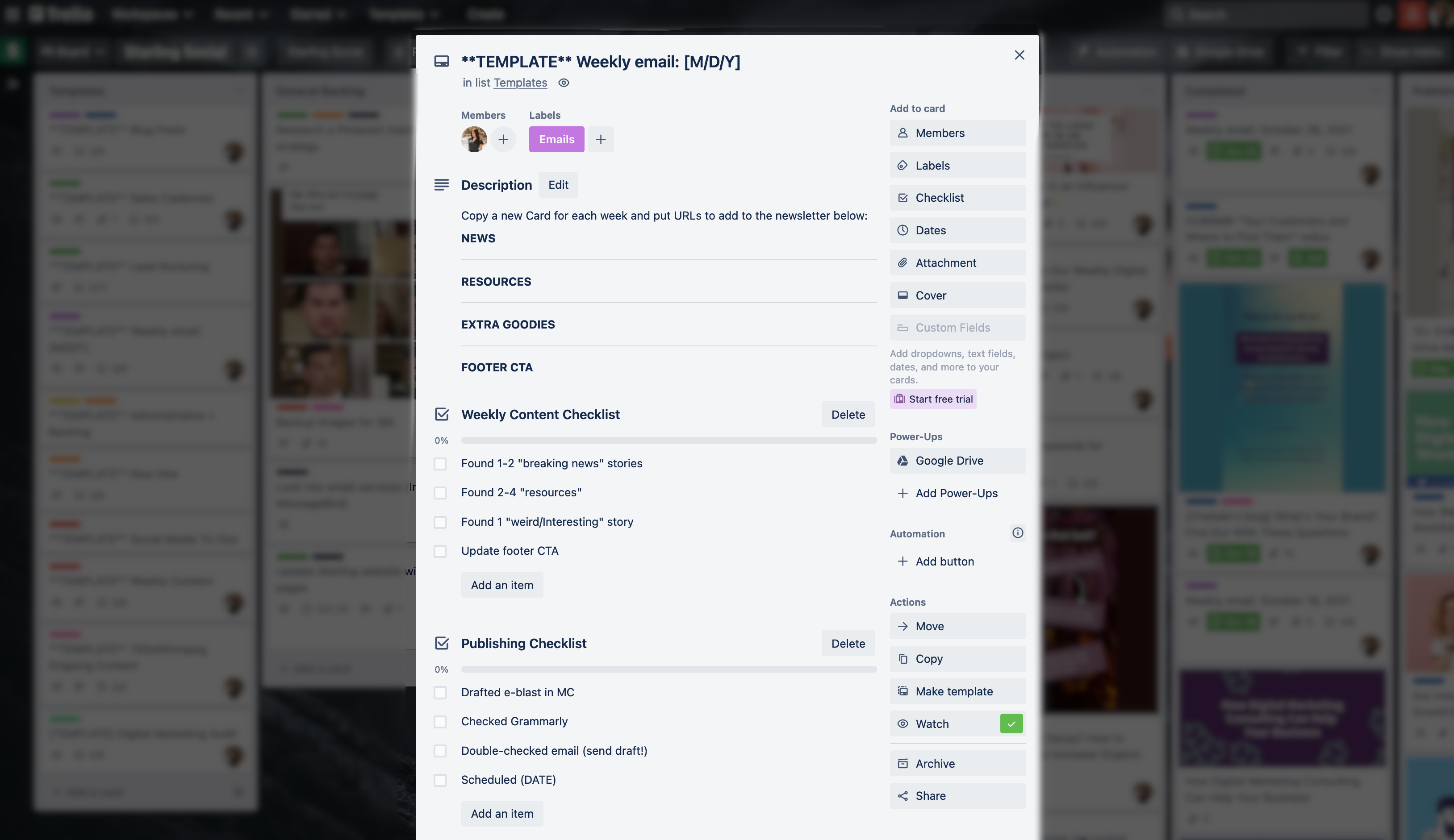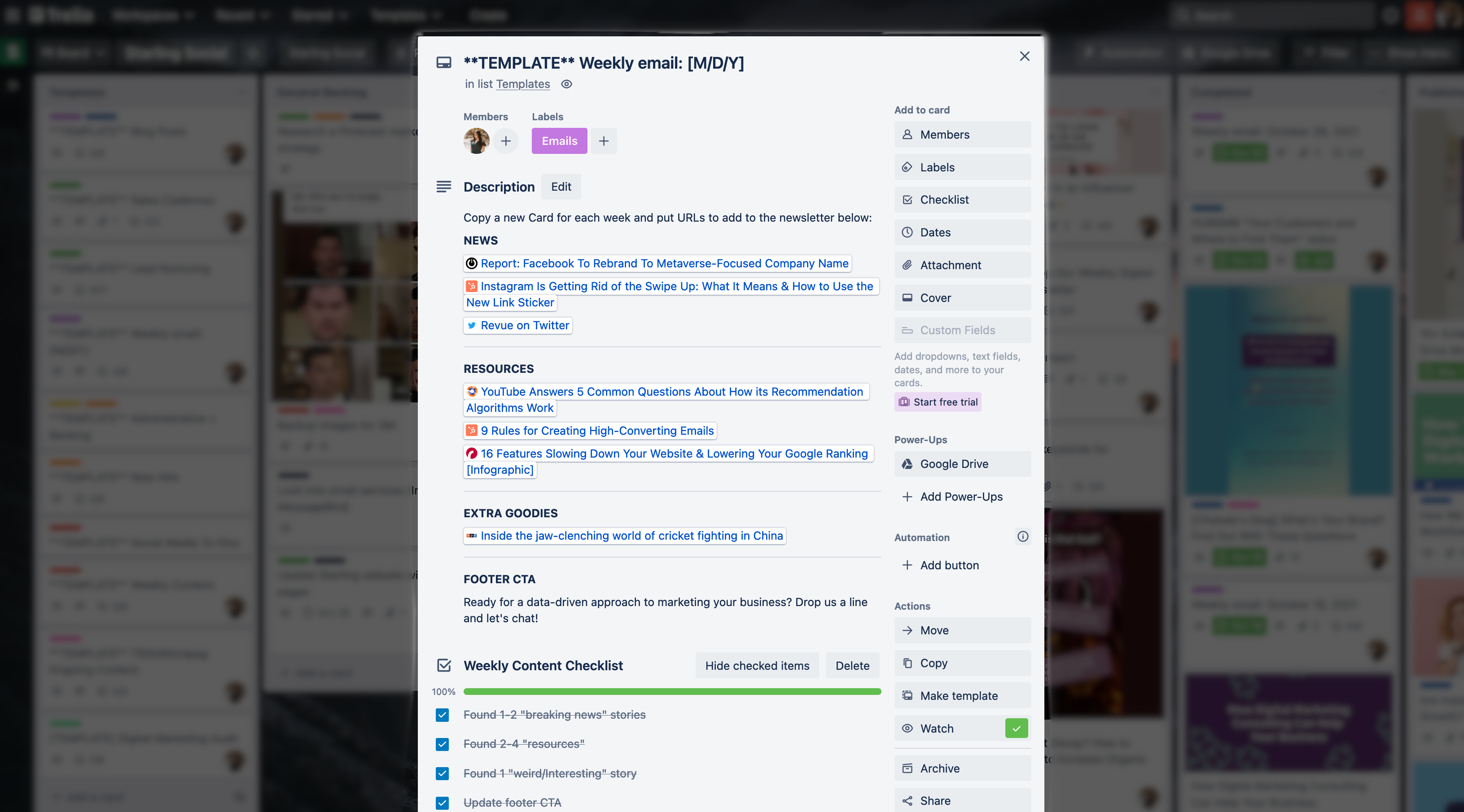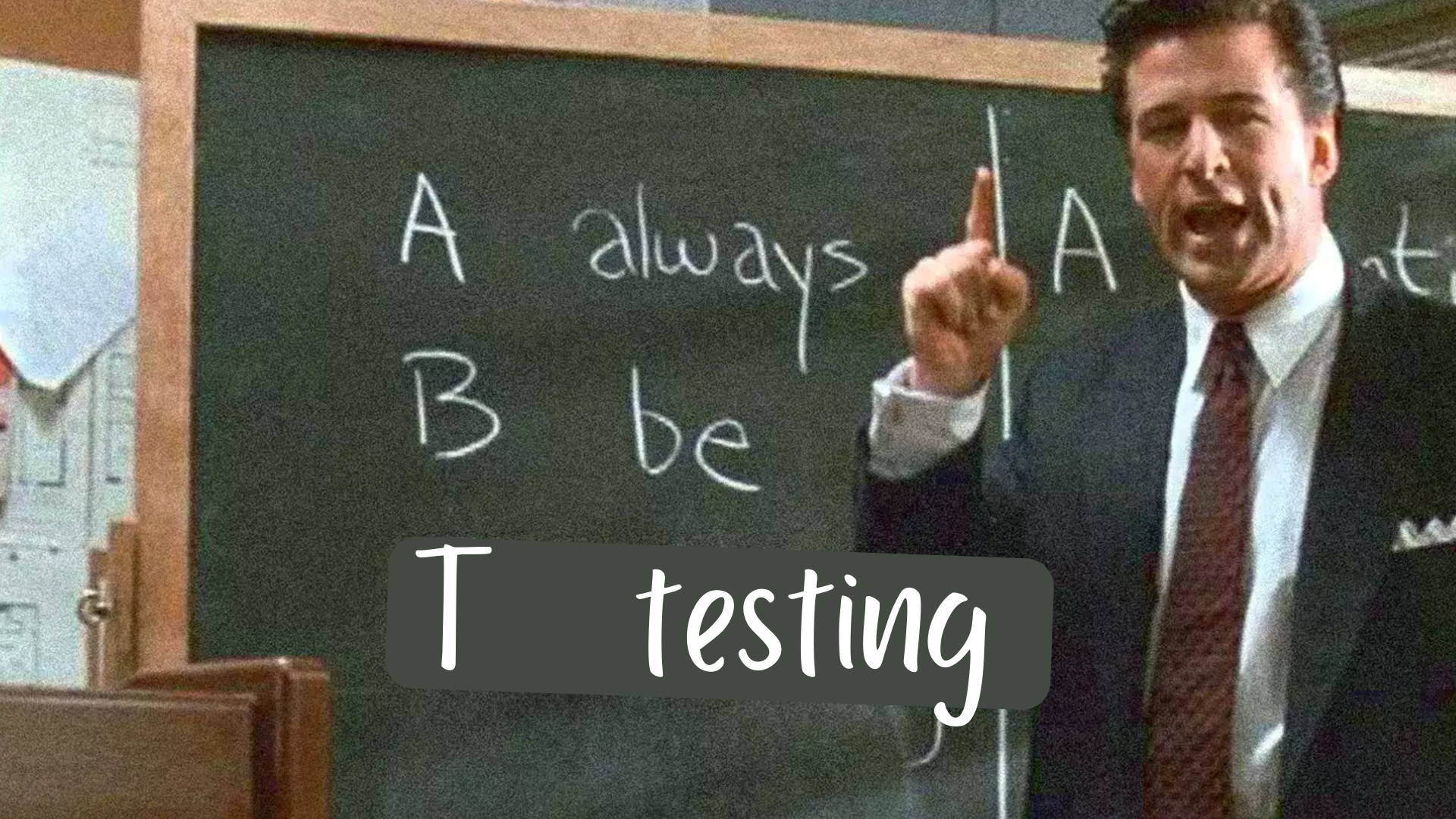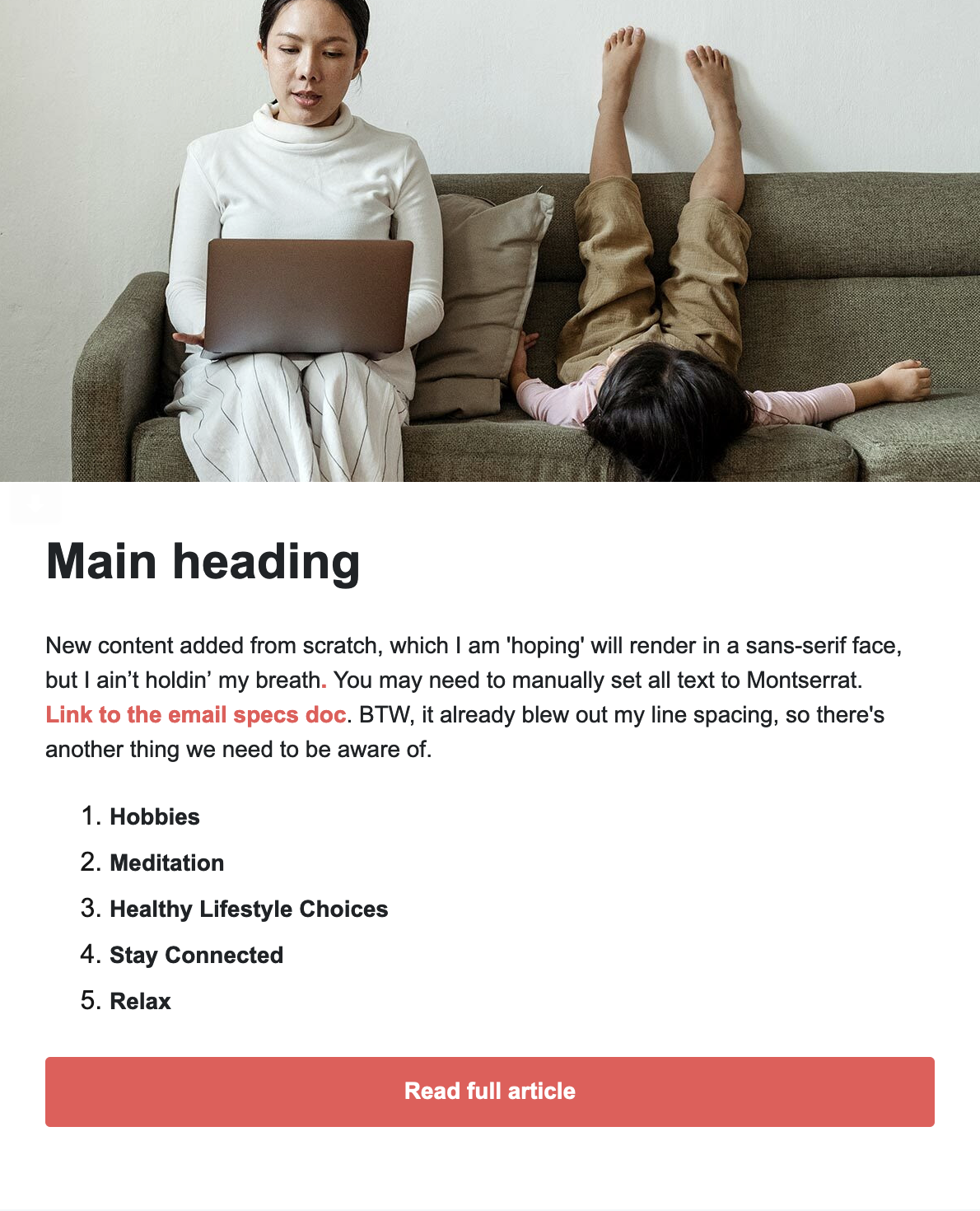How We Develop Our Weekly Digital Marketing Email Newsletter
By: Alyson Shane, President
Email newsletters are one of the most important aspects of a successful digital marketing strategy. As subscription-based models, they’re great at driving brand awareness, increasing visibility, and creating opportunities for brands to communicate consistently with their target audience.
While some email newsletters are promotional in nature — letting you know about a new product or service, for example — but some newsletters are educational in nature. They offer insights that help educate the reader, which builds brand credibility and authority.
Today I’m going to be talking about Starling Social’s weekly digital marketing newsletter. I’ll cover why I chose the frequency, topics, share my process, and end with some email marketing best practices so you can start creating your own.
Some background on newsletters
I’ve been publishing content online for over 20 years, which means that I’ve seen a lot of digital marketing trends come and go.
Email has been around since the 1980’s but it didn’t start to become popular until 1996 when companies like Hotmail and RocketMail started offering free webmail services that didn’t need specific software to use.
Now we could send and receive emails easily… but that also meant that unwanted messages started to become a real problem. It got so bad that in 1998, spam was added to the New Oxford Dictionary.
As an aside: many people believe that using “spam” to describe junk email comes from a classic Monty Python skit that features eaters at a diner being bombarded with annoying repetitive lyrics about “spam” which none of them like or want.
Why have an email newsletter?
As a marketing tool, email newsletters are worth their weight in gold.
Email marketing has an average return-on-investment (ROI) of 42:1, meaning that for every $1 dollar you spend, you can expect to get an average of $42 back in future sales.
Why are emails so powerful? Because everyone uses email.
Millennials use email the most, with a study by Adobe finding that people born between 1981 and 1996 spend a whopping 6.4 hours a day in their inboxes, with 41% checking their email in bed and before and after work and people over that age spend 5 hours a day on email.
That’s a huge time window to get in front of your audience!
Why a weekly newsletter?
The best frequency for newsletters is no more than twice a week and at least once a month. In fact, more people are reporting that they want to hear from brands they care about on a regular basis:
“61% of consumers want to see at least one email a week from brands they follow.”
The data tells me that a weekly newsletter is what my audience likely wants in terms of frequency.
Why focus on digital marketing news?
Knowing how often to send our email newsletter is great and all — but what about the content?
I wanted to create an email newsletter that was useful and purpose-driven, and that I would want to read if it were showing up in my inbox.
I also knew that lots of business owners and marketing managers struggle to keep up with the latest news in their industry. Things move so fast that it can feel overwhelming to try and keep track of it all, so I decided to collect the information I was seeing online and combine it into a single weekly update.
As a result, our newsletter is broken up into these sections:
- News. This section covers new or upcoming features, new products or tools, and other timely information
- Resources. A roundup of the best “how to” and informational articles from the past week
- Extra goodies. A fun, interesting, or weird article to keep things spicy
This has an added benefit for me: as the owner of a digital marketing agency, I have a responsibility to be as up-to-date on the latest marketing news and best practices.
Personally curating and writing our weekly email newsletter means I’ve always got my thumb on the pulse of my industry, which helps me and my team deliver better results four clients.
Why do I send our email newsletter on Tuesdays?
Technically Monday, Wednesday, and Friday are the best days to send emails, but I decided to send Starling’s email newsletter every Tuesday morning.
This is partially to give myself room to include any news that might have happened over the weekend, but it’s mostly because I don’t want to send our subscribers something that feels like another to-do first thing Monday morning.
Luckily for me, it seems like this strategy is working. At the time of writing our email newsletters have an average open rate of 34.6%, which is higher than the industry benchmark of 17.38%, and average click-through rate of 5.7%, which is above the industry average of 2.4%.
How I develop our weekly email newsletter
I use four tools to help me curate, write and send our newsletter each week, which are:
- Feedly
- Trello
- MailChimp
- Grammarly
Feedly is an RSS reader that I use to aggregate digital marketing news from various sites online.
I check Feedly once a day, and again every Monday morning before I start drafting the newsletter to make sure I haven’t missed anything over the weekend.
Trello is the project management tool we use at Starling Social and I swear by it. In addition to having Trello boards for all of our clients, I have a private, “Starling Social” specific board, which is where I keep track of the things I have going on with the business.
Trello uses a kanban-style system to track tasks on “cards”, so I created a template card for the email newsletter that looks like this:

I create a new card every Monday after I’ve finished scheduling the newsletter, move it to my “doing” column in Trello, and add to it throughout the week.
Since I check Feedly every day and read a ridiculous amount of articles online, after a few days my card starts to look like this:

MailChimp is where I draft, test, and send our email newsletters. My process here is pretty simple:
- Open two windows: one with the corresponding Trello card, and one with my MailChimp draft — this is just a personal preference so I tab over less often.
- Update the subject line and preheader. I like to use our preheader as an additional call-to-action (CTA) to entice people to open the email.
- Update the headers so they match the new articles we’ll be sharing.
- Fill in the body text. I like to add commentary instead of copy/pasting from the article so our subscribers get a sense of our brand’s personality (and also mine).
- Copy/paste it into Grammarly to make sure it doesn’t have any glaring typos or grammatical errors.
- Read it out loud. This is my #1 rule for writing and I’ve practiced it since my blogging days. Reading your work aloud helps with clarity, brevity, and sentence structure.
- Preview the email to check how it will appear on mobile and across different devices.
- Send a draft to myself. Another rule! This way I can double check my subject line, preheader, and email body all look and sound the way I want it to sound.
- Schedule it to send the next day.
It’s that simple! A few steps every week and I have a fun, useful, and (apparently) popular weekly digital marketing newsletter ready to go.
Protip: I like to post on social media about our newsletter once I’m finished scheduling it and link to our subscription page so people can get in on that week’s send if they want. You’d be surprised at how well this works!
Email newsletter best practices
Now that I’ve spent some time talking about my process, let’s review some email newsletter best practices so you can start sending emails that your audience loves to read:
Let subscribers know what to expect. Clear expectations help you find subscribers who will be more engaged with your emails. There are two places where you can do this:
- On your website, either on a subscription page or in a popup
- In your welcome email, where you can reiterate what subscribers get from signing up
Always Be Testing (ABT). A/B test different subject lines, send times, and content layouts to figure out what your subscribers like best and continually optimize towards whatever’s yielding the best results.

Keep your subject lines catchy. 35% of people say they’ll open an email based on the subject line alone. Here are some tips to get you started:
- Keep it brief, no more than 9-10 words
- Use relevant emojis to catch people’s attention
- Be clear about what’s inside the email
- Use language that sparks one of these four emotions:
- Happiness
- Excitement
- Curiosity
- Urgency
Use your preheader as a call-to-action (CTA). Preheaders are your second chance to convince someone to open your email, so be strategic in how you use them.
Never pre-schedule your drafts in advance. Always leave your email newsletter as a “draft” until it’s ready to send. Otherwise you risk this happening:

Choose the right length. Starling Social’s weekly newsletter is longer by default because we’re including write-ups about the article we’re sharing, but longer isn’t always better. Here’s how to choose the right length for your email:
Short newsletters are great for redirecting to a bigger piece of content — a single blog post, webinar, video, registration or product page.
Longer newsletters tend to be either informational (like ours) or promotional, like the kind you’d get from an ecommerce brand.
Optimize for mobile. About 46% of all emails are read on mobile devices, so keep the size of the screen in mind when crafting your email newsletter. Some best practices include:
- Avoid large blocks of text
- Avoid large images
- Make CTA’s clear on their own line or button
- Preview it for mobile and across devices before sending it
Be strategic with your open times. Data shows that emails are best sent at either 10:00 AM, or 1:00 PM, but I suggest starting with these times, testing, and adjusting based on your results.
As an aside: I send our email newsletter at 8:15 AM and have been getting better open rates than when I sent it later in the day. Like I said: test, test, test!
Use this process to maximize your email marketing ROI
Figuring out how to create an email newsletter that people want to open and read on a regular basis takes time, patience, and process.
But email newsletters are also a great way to generate awareness, create trust and brand authority, and stay top-of-mind among your most engaged potential customers.
Now that you’ve read all about how I develop Starling Social’s weekly digital marketing email newsletter, you can take these tips and apply them to your campaigns.
And hey — if you’d like to stay up-to-date with the latest news and strategies (like this post) just subscribe to our newsletter and get ‘em sent right to you every Tuesday morning.

